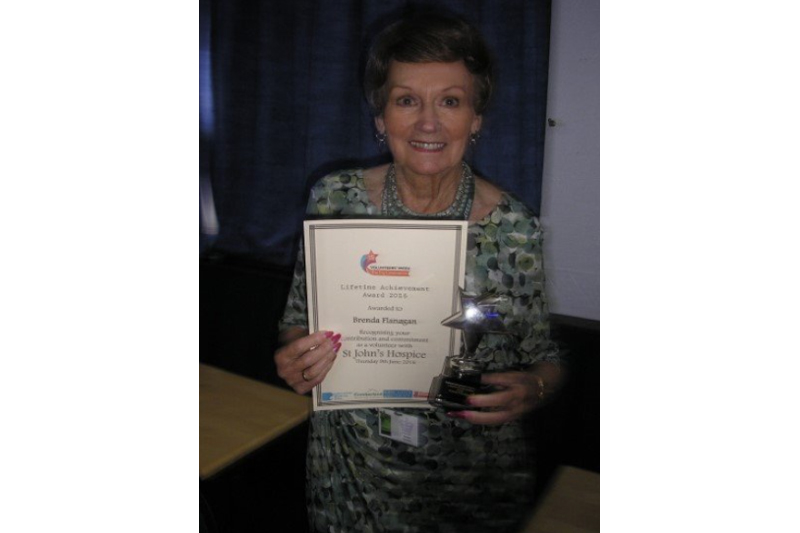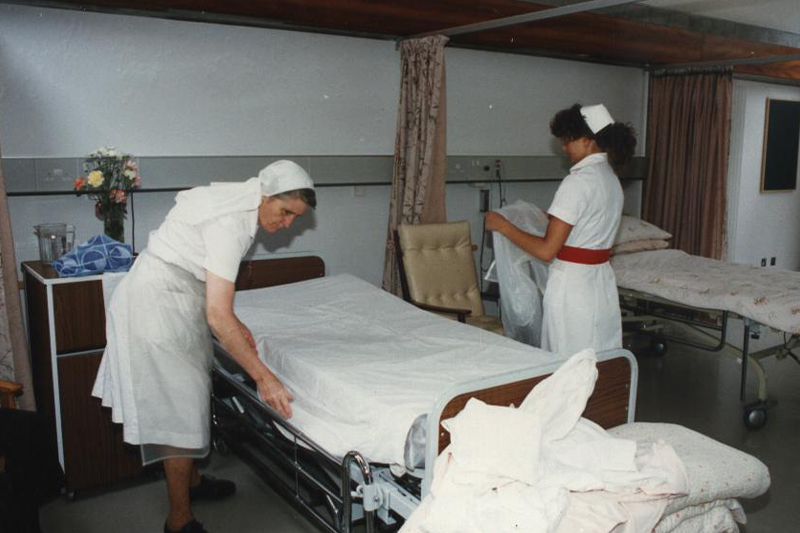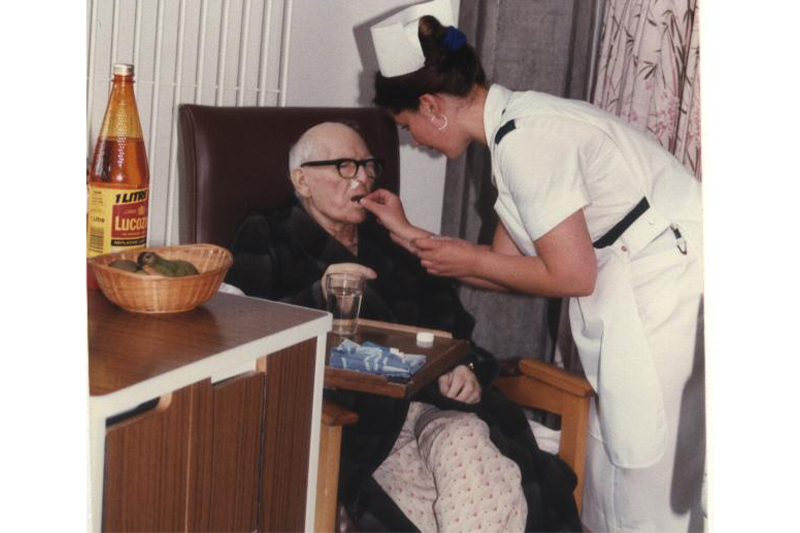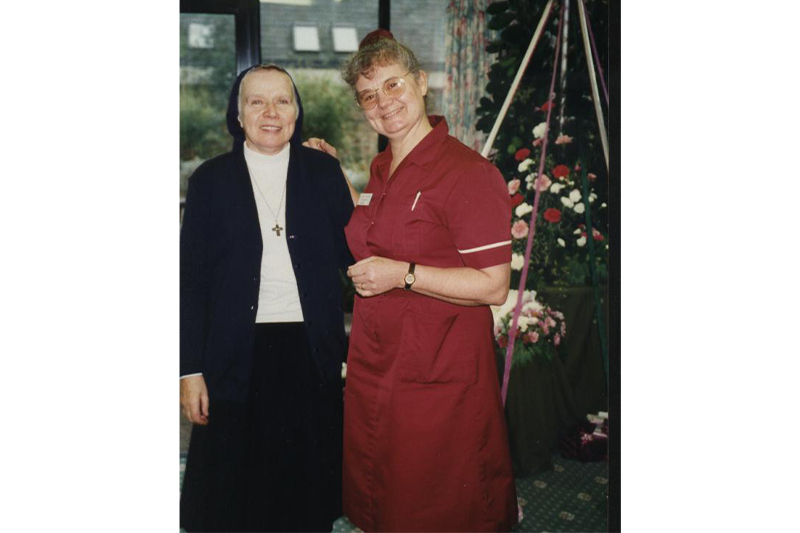Fundraising
How you can support
Shop with St John's
Wills
Resources
Results for {phrase} ({results_count} of {results_count_total})
Displaying {results_count} results of {results_count_total}
Basket
Secure checkout
0
Donate
As St John’s Hospice opens its doors to the public in 1986, it quickly establishes itself as a vital part of local health and social care services. In this section we explore the huge contributions of the many supporter groups who helped ensure that not only St John’s opened, but it stayed open. We also meet the early staff of St John’s and look at the beginnings of the huge financial challenge of funding a hospice as the years pass bye.
The need and desire for a local hospice led to the development of many support groups; all working tirelessly to raise funds for a purpose-built hospice. In 1985 the various support groups developed during the hospice building appeal become part of an umbrella organisation: The Friends of St John’s Hospice. The first group: the Friends of St John of God Hospital group became the Silverdale support group, fundraising within the overall Friends of St John’s Hospice movement.
In 1990 Geoff Marsden was appointed as a Trustee to be a formal voice for the Friends of St John’s Hospice on the board – continuing to ensure that their voice played an active part in the future of St John’s Hospice.
Once the building appeal was completed (no mean feat) the Friends of St John’s Hospice oversaw numerous small and larger events raising even more funds for fixtures, fittings and other equipment.

 Sister Aine collecting a cheque from Yorkshire Building Society
Sister Aine collecting a cheque from Yorkshire Building Society Sister Callistus collecting a cheque from the Halifax
Sister Callistus collecting a cheque from the Halifax Sister Aine in the Hospice receiving a fundraising cheque
Sister Aine in the Hospice receiving a fundraising cheque One of the first fundraising Garden Fetes in 1989
One of the first fundraising Garden Fetes in 1989 One of the first fundraising Garden Fetes in 1989
One of the first fundraising Garden Fetes in 19891990 saw the first sale by St John’s Christmas of cards designed by Anne, Duchess of Norfolk who was a keen amateur artist, with the cards being provided by the national ‘Help the Hospices’ movement, of which she was co-founder.
By 1991 the Hospice had been open for five years and The Friends of St John’s Hospice continued generating income, raising £17,000 in that year alone. Subsequent years of fundraising by the Friends bought a host of items for patient care, and still do today for example through their fabulous Afternoon Tea events.
Music has always and will always play a key part of the Hospice fundraising work. A joint musical event, ‘Hospice Voices’, promoted by the national Help the Hospices movement was held with St Catherine’s Hospice (Preston) and St Mary’s (Ulverston), followed by an evening of Music and Mirth in 1992 at Levens Hall, with Cinderella the next year. The latter was such a success it raised £3000 and was repeated at the Hospice in January 1993.
Brenda Flanagan reflects on her involvement in St John’s Hospice, from the early days of marshalling support for the hospice in the local community, her work with volunteers and her long involvement with the Friends of St John’.
Sisters from Sister Aine’s community rotated through the hospice to support the work. Our Lady of Apostles is a working order, having undertaken missionary work in the UK and overseas; Sister Callistus and Sister Aine had worked in Nigeria, for example. They brought their knowledge back home and transferred their learning to the local communities they worked in, such as St John’s learning the local systems on the way.
Volunteers and nurses, inspired by the work at St John’s came on board and local GPs continued to refer patients. From then, until now, the ethos of hospice care is that it should be available to those who need it, and without fear of discrimination. For example, in 1987 St John’s agreed that AIDS patients could be admitted subject to following all recognised precautions.
 Sister Aine, Callistus and staff with some of the 1st patients
Sister Aine, Callistus and staff with some of the 1st patients  Very early days on the Inpatient Ward
Very early days on the Inpatient Ward Early days of nursing on the Ward
Early days of nursing on the Ward Susie Roth, Brenda Flanagan and Jean Lawrence and others promote an early Sunflower Appeal
Susie Roth, Brenda Flanagan and Jean Lawrence and others promote an early Sunflower Appeal Sister Aine with Susie Roth, the first Matron after Sister Aine
Sister Aine with Susie Roth, the first Matron after Sister Aine Fundraising for operating costs gather support
Fundraising for operating costs gather support Jean Laurence other celebrate 10 years of St John's with a Ceileh
Jean Laurence other celebrate 10 years of St John's with a CeilehBehind the scenes, financial pressures made their subtle mark – the local Health Authority funding was not enough for the evolving hospice service. June 1993 saw the first national sunflower collection to raise money for hospice care, as hospices developed throughout the UK. In 1986 Dr Malcolm McIllmurray was appointed medical director and additional nurses were recruited, funds allowing, to try and meet the growing demand for hospice care.
As ever, the incredible community stepped up their efforts even further to provide the much-needed funding. Local Health Authority funding was providing less than a third of the funds needed to provide this essential care, the remaining two-thirds were raised by the community. Nearly 40 years later, the local NHS provides approximately 25% of the funding needed to run Hospice services. St John’s wouldn’t be here without its incredible community: we will never forget or take for granted, this kindness.
Jean Lawrence has been involved with St John’s Hospice from the very early days. She has seen the hospice grow and adapt over the years. As well as contributing as a staff member and later as a volunteer, Jean has been very close with many of the people who have helped make St John’s what it is today.
Malcolm McIllmurray DM FRCP, a consultant physician and medical oncologist, aided by a Health Visitor, Pippa Holdcroft, were providing a cancer clinic and offering counselling and therapeutic support, under the name “CancerCare” in hall in Ryelands Park in 1986.
St John’s worked closely with Cancer Care, as it developed, supporting each other’s patients where possible. The two separate charities had their own areas of expertise and still do today.
Cancer Care focused on providing supportive care for people with cancer- whether the cancer was curable or not. St John’s focussed on palliative & end of life care for patients with ‘incurable’ life shortening illness such as cancer and other illnesses. St John’s Hospice continues to care for cancer and other life shortening illnesses on the inpatient ward and in the community. Cancer Care provide services such as counselling and group support activities.
Together the two charities set up three joint charity shops. The shops are now purely St John’s Hospice Shops and continue to play a fundamental role in directly financing care for hospice patients and families.
Cancer Care and St John’s Hospice remain two separate neighbouring charities, in two different premises with separate income generation activities.


Malcolm McIllmurray was heavily involved in the very development of St John’s Hospice, long before it had a home on Slyne Road or a plan to pay for its continued operation. He worked closely with St Aine and helped to develop what would become ‘palliative care’. He also shares some amazing examples of the staff of St John’s Hospice going above and beyond for its patients and their families a trend that continues to this day.